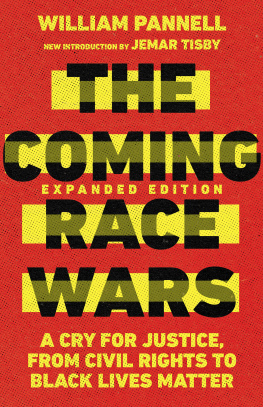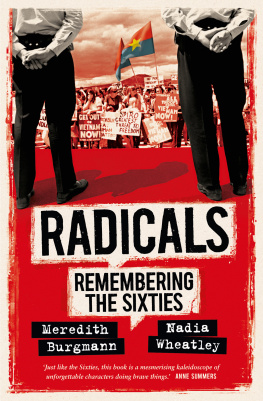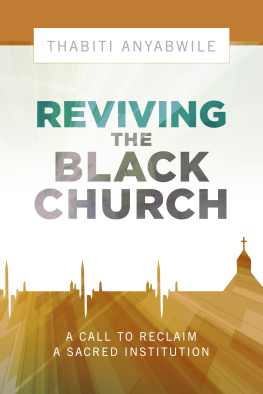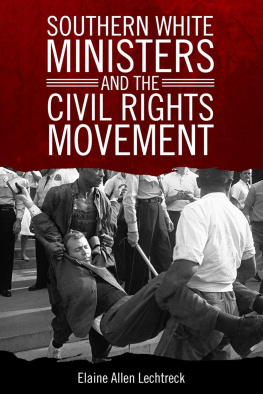BLACK CHURCH IN THE SIXTIES
BLACK CHURCH
IN THE SIXTIES
Hart M. Nelsen &
Anne Kusener Nelsen
ISBN: 978-0-8131-5419-0
Library of Congress Catalog Card Number: 74-18937
Copyright 1975 by The University Press of Kentucky
A statewide cooperative scholarly publishing agency serving Berea College, Centre College of Kentucky, Eastern Kentucky University, Georgetown College, Kentucky Historical Society, Kentucky State University, Morehead State University, Murray State University, Northern Kentucky State College, Transylvania University, University of Kentucky, University of Louisville, and Western Kentucky University.
Editorial and Sales Offices: Lexington, Kentucky 40506
for Noah and Nova
CONTENTS
2: The Black Church
before World War I
3: The Great Migration to the
Beginning of the Civil
Rights Movement
4: Racial Differences in
Religious Dimensions
5: Religiosity and Militancy:
An Indirect Examination
of a Relationship
6: Religiosity and Militancy:
A Direct Examination
ACKNOWLEDGMENTS
The cooperation of numerous persons made this study possible. A large portion of the volume incorporates work done by the first author while he held a 15-months National Science Foundation Faculty Fellowship (No. 69126). That part of the study incorporated valuable suggestions from John D. McCarthy, Ernest Q. Campbell, Mayer N. Zald, Leo Rigsby, and Kelly Miller Smithall of Vanderbilt Universityand Hugh P. Whitt of the University of Nebraska at Lincoln.
Other individuals have also been of inestimable help in this study. Raytha L. Yokley and Thomas W. Madron of Western Kentucky University encouraged the study in numerous ways. Both kindly gave permission to use data jointly collected under PHS Research Grant 1 RO1 MH 16573 from the National Institute of Mental Health. We owe thanks to NIMH for support of this data collection and analysis. The conclusions drawn by us can in no way be attributed to policy of NIMH. Additional support for this study was provided by the Research Fund Committee of The Catholic University of America (from a National Science Foundation Institutional Grant); thanks are extended to the committee and to Drs. James P. OConnor, John J. Murphy, and Eugene R. Kennedy.
The help of black interviewers in collecting the Bowling Green data deserves special thanks (the 97 percent completion rate is testimony to the quality of their work). The interviewers were L. D. Britt, Sarah Davidson, Lynda Dickson, Debbie Hart, Artanzie Hayne, Edith Johnson, Dorothy Offutt, Lynda Proctor, Mamie Starks, and Shelby White. Other thanks go to Linda Logan, a superb coder, and Paul Messick, who gave valuable research assistance.
Several organizations and individuals gave us permission to use their data for secondary analysis. The identification of the 30 data sets and sources follows:
The Black Church As a Politicizing Agency. The data were collected in 1970-1971, Bowling Green, Kentucky.
A Study of Religious Participation, Project 849, Detroit Area Study, Gerhard Lenski, Director of the 1958 Survey. The data were supplied by the Survey Research Center of the University of Michigan, with permission from Gerhard Lenski.
The Public Images of Mental Health Services Study, collected for and directed by Dr. Jack Elinson, Dr. Elena Padilla, and Dr. Marvin E. Perkins. The data were supplied by the Research Archives of the Columbia University School of Public Health and Administrative Medicine, with permission of the investigators. The interpretations presented in this volume are ours.
Negro Political Attitudes, Gary T. Marx, Principal Investigator. The data were furnished by the Inter-University Consortium for Political Research, the University of Michigan.
The Roper Public Opinion Research Center, together with the Gallup Poll organization, for the following data sets (all American Institute of Public Opinion national surveys): Numbers 539 (November 1954), 580 (March 1957), 625 (February 1960), 642 (March 1961), 655 (February 1962), 658 (May 1962), 660 (June 1962), 673 (May 1963), 676 (August 1963), 681 (December 1963), 695 (July 1964), 706 (February 1965), 708 (March 1965), 710 (April 1965), 711 (May 1965), 734 (September 1966), 738 (December 1966), 742 (March 1967), 749 (August 1967), 757 (January 1968), 758 (February 1968), 760 (April 1968), 764 (June 1968), 766 (August 1968), and 780 and 781 (May 1969).
With gratitude we remember the encouragement given us in this research and other studies by Professors Samuel Blizzard and V. Jacque Voegeli. Finally, let us note our indebtedness to earlier researchers of the black church, especially Benjamin E. Mays and Joseph W. Nicholson whose landmark study The Negros Church was published in 1933.
1:
Introduction
The study of the black church and black religiosity offers a unique opportunity to sociologists.
A study in black religion (which means, in large part, black Protestantism) should give insight into the relationship which black Americans have with their society, as indicated, for example, by otherworldly versus thisworldly orientations. Such a study might also determine the degree to which social cohesion exists among black Americans themselves, or the degree to which the black church acts as a communal organization.
In an article published in 1964, Peter Rossi observed the need for additional research on the roles of ethnic groups and religious institutions and on their origins and maintenance. Rossi discussed numerous directions which race relations research might take, including examination of the forms of organization taken by black protest movements. The pluralist view, however, would not foresee the waning and eventual disappearance of the black church, since black institutions would retain their identities. The strength of these institutions would constitute a variable in itself, depending upon numerous factors, including the degree to which blacks believe an integrated society is possible and how near this dream is.
Black Religiosity As Sectarian
Blacks have traditionally been viewed as sectarian in their religious orientation. Argyle, for example, has commented, Minority groups are often underprivileged and show an above-average level of religious activity, especially in sect religion, as in the instance of the American Negroes.
The fact that most black church members are Baptist encourages the sectarian interpretation by whites who interpret this denominational complex (the National Baptist Convention of the U.S.A., the National Baptist Convention of America, and the Progressive Baptist Convention) in the light of their understanding of the Southern Baptist orientations of whites.
In viewing the black church within the sect-church framework, many sociologists readily write it off as not concerned with social problems.
Scholars acquainted with the church-sect typology too quickly project from this knowledge of the ideology of white sectarianism a unidimensionality for the religious beliefs of blacks, including such diverse attributes as preference for emotional worship, a literal interpretation of the scripture, and an unwillingness for the religious organization to meddle in political matters. The compatibility of a conservative religious outlook (for example, one having a traditional view of the Bible) with a concern for solving race problems would probably be dismissed by white and black sociologists alike.








